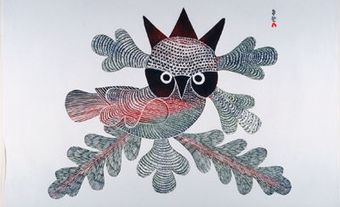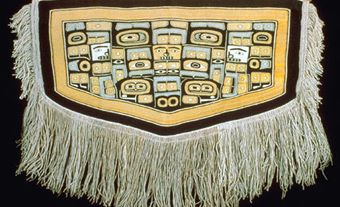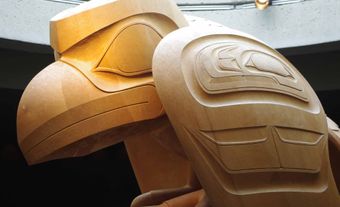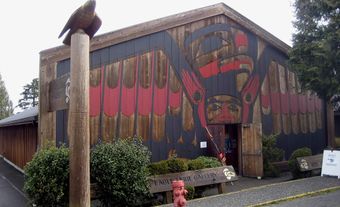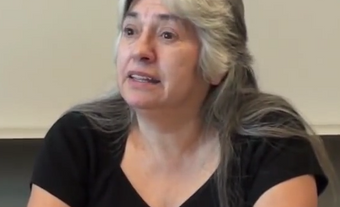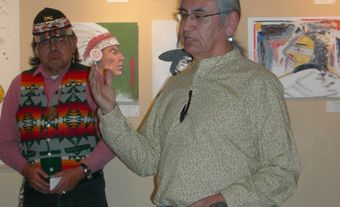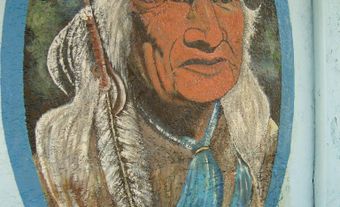Emily Carr, painter, writer (born 13 December 1871 in Victoria, BC; died 2 March 1945 in Victoria). Along with Tom Thomson, the Group of Seven and David Milne, Emily Carr was one of the pre-eminent Canadian painters of the first half of the 20th century, and perhaps the most original. She was also one of the only major female artists of that period in either North America or Europe. Her bold, almost hallucinatory works depict nature as a furious vortex of organic growth. They have also been criticized as appropriations of Indigenous culture. Carr was also a celebrated author. Klee Wyck, a collection of short stories based on her experiences with Indigenous people, won a Governor General's Literary Award in 1941.

Early Life
Carr’s parents were British immigrants. They settled in the small provincial town of Victoria, British Columbia. Her father became a successful merchant. The second-youngest of nine children, Carr grew up with a brother and four older sisters. It was a disciplined and orderly household where English manners and values were maintained. Carr had no serious artistic role models growing up but enjoyed drawing as a child.
Carr’s mother died in 1886; her father in 1888 (both of tuberculosis). Once she turned 18, she persuaded her guardians to permit her to study art at the California School of Design in San Francisco. There she learned the basics of the craft of painting. When she returned home three years later, she began painting in watercolour. She also set up art classes for children.
Early Artistic Career
A study trip to England in 1899 did little to advance Carr’s art. A lengthy illness kept her there until 1905, when she returned to Victoria. In 1910, she was determined to find out what the new modernist art was all about. She gathered her savings and set out with her sister Alice for France. In Paris, she took classes at Studio Colarossi. However, she found private study with British artist Harry Gibb more helpful. The radical experiments in cubism and fauvism then being undertaken by Pablo Picasso, Georges Braque, Henri Matisse and others in Paris escaped her. But she developed her own bold, colourful, post-impressionist style of painting. She returned to Victoria in 1912.
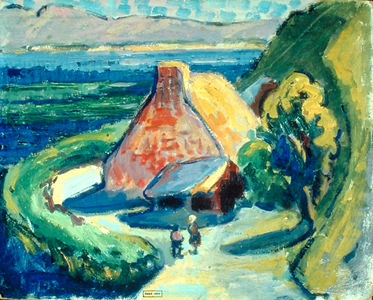
Exposure to Indigenous Culture
Even before 1908, when she visited several southern Kwakiutl villages, Carr had shown an interest in Indigenous peoples, their traditional culture and their material works; especially longhouses, totem poles and masks. At that time, Indigenous culture was thought to be dying under waves of white settler encroachment. Despite her keen interest in Indigenous culture, Carr shared the prevailing attitude that this was an inevitable process.
DID YOU KNOW?
In 1862–63, a smallpox epidemic that began in Victoria decimated the area’s Indigenous population. Some 14,000 Indigenous people along the Northwest Coast — roughly half of the region’s population — died. The epidemic left mass gravesites, grieving survivors, and abandoned villages. (See Smallpox Epidemic in British Columbia.)
After her return from France in the summer of 1912, Carr decided to make a visual record of Indigenous totem poles in their village settings before they disappeared. She made an ambitious six-week trip north to the Queen Charlotte Islands (now Haida Gwaii) and the Skeena River. There she documented the art of the Haida, Gitksan and Tsimshian peoples. The drawings and watercolours she made on this and later trips gave her the source material for one of the two great themes of her painting career: the material presence of Indigenous cultures of the past. Her adventurous trips in search of this material also led her more deeply into her second great theme: the distinctive landscape of Canada’s West Coast.
Carr painted in her vivid, painterly “French style” for about 10 years. She produced small works that would have been seen as advanced in any part of Canada. But it was not the approach that would lead her into the fullness of her achievement. By 1913, she had produced a substantial body of distinguished work. But she was dispirited by the absence of encouragement and support and was unable to live by the sale of her art. She built a small apartment house in Victoria for income. For the next 15 depressing years, she managed the apartment and painted little.
Career Breakthrough
The period of mature, highly original work on which Carr’s reputation rests began when she was 57 years old. It was triggered by the discovery of her early work on Indigenous subjects by an ethnologist studying in British Columbia. He brought her paintings of Indigenous themes to the attention of curators at the National Gallery of Canada. They were in the process of organizing an exhibition of Northwest Coast Indigenous art. Carr was invited to participate in the exhibition and attended the opening in November 1927.
It was there that she met Lawren Harris and other members of the Group of Seven, then the leading art group in English Canada. They welcomed her into their company as an artist of their own stature. Their paintings of the rugged landscape of Northern Ontario impressed her greatly; as did their avowed intention to produce a distinctively Canadian art. She quickly snapped out of her feeling of artistic isolation and returned to painting with renewed ambition.
Following this success, and with Lawren Harris as her mentor, Carr began to paint the bold, almost hallucinatory canvases with which many people identify her; paintings of totem poles set deep in forest locations, or the sites of abandoned Indigenous villages. After a year or two, she left Indigenous subjects to devote herself to nature themes.
From 1928 on, critical recognition and exposure in major exhibitions — like the National Gallery of Canada and the American Federation of Artists in Washington, DC — began to come her way. There was even the occasional sale, though never enough to improve her financial situation. In full mastery of her talents and with deepening vision, she continued to produce a great body of paintings. They are freely expressive of the large rhythms of Western forests, driftwood-tossed beaches, and expansive skies.
In Carr’s mature paintings, such as Church at Yuquot Village (formerly Indian Church, 1929), nature is a furious vortex of organic growth. It is depicted with curving shapes that create the impression of constant movement and transformation. By comparison, the human element — churches, houses, totem poles — seem small and fragile.
Writing Career
In 1937, Carr suffered her first heart attack. This marked the beginning of a decline in her health and in her energy required for painting. She began to devote more time to writing, an activity she had begun years earlier at the encouragement of Ira Dilworth, an educator and CBC executive. Carr’s first book, Klee Wyck, a collection of short stories based on her experiences with Indigenous people, was published in 1941. That year also effectively marked the end of her painting career.
DID YOU KNOW?
Klee Wyck (“Laughing One”) is the name the Nuu-chah-nulth (Nootka) people gave Emily Carr. Her book of the same name is an evocative memoir. It describes in vivid detail the influence that the Indigenous people and culture of the Northwest Coast had on her and her art.
Klee Wyck won a Governor General's Literary Award for non-fiction in 1941. It was followed by the publication of four other books, two of them posthumously. Printed in more than 20 languages, they are all autobiographical in nature, portraying a person of enormous spirit and individuality. Written in a simple, unpretentious style, they quickly won Carr the popular audience that eluded her more difficult paintings. In the end, however, it is primarily as a painter that Carr has won critical acclaim.
Recent Exhibitions
In recent decades, Carr’s appeal has extended beyond Canada's borders. While she remains a national icon, she has begun to be appreciated as an important 20th-century artist. In 2001–02, she was included alongside Georgia O'Keeffe and Frida Kahlo in a critically acclaimed touring exhibition titled Places of Their Own. It was organized by the McMichael Canadian Art Collection.
In 2012, seven of her paintings from the permanent collection of the Vancouver Art Gallery were selected for display at dOCUMENTA (13), the prestigious international art showcase in Kassel, Germany. In 2020, Emily Carr: Fresh Seeing — French Modernism and the West Coast was exhibited at the Royal BC Museum in Victoria. It included 67 works by Carr and some of her Paris contemporaries and was reportedly the largest ever exhibition of Carr’s Paris paintings. Also in 2020, the Beaverbrook Art Gallery in New Brunswick showcased more than 50 of Carr’s paintings. In 2022, some of her landscapes were among more than 200 works presented as part of Uninvited: Canadian Women Artists in the Modern Moment. The show, which originated at the McMichael gallery and was also exhibited at the Vancouver Art Gallery, highlighted the work of notable female artists of the 1920s–40s who were largely excluded by the artistic establishment of the day.
Legacy
More than half a century after her death, Emily Carr has become a Canadian icon. She could not be thought of as a careerist, yet her timing turned out to be perfect in several respects. Her long preoccupation with Northwest Coast Indigenous cultures coincided with the start of a rising tide of awareness and confident self-identification on the part of Indigenous people, who had for some time been considered part of a moribund culture. At the same time, it coincided with a recognition by the dominant society that First Nations issues must be addressed.
Carr has been harshly criticized for her appropriation of Indigenous culture. Her passionate involvement with nature and its portrayal coincided with a growing popular awareness of environmental issues and an accompanying sense of loss associated with the disappearance of nature.
The two main themes of Carr’s work — Indigenous culture and the natural world — were side doors through which ordinary people could access her art. Other factors also contributed to her fame. Her struggle against the obstacles that faced women of her day to become an artist of stunning originality and strength made her a favourite of the women's movement. Also, the pattern of her career — with its delayed start (not until the age of 57) and late fulfillment — created an appealing personal narrative. Still, such considerations sidestep the central fact that it was her painterly skill and vision that enabled her to give form to a Northwest mythos that was so carefully distilled in her imagination. Even though we may never have visited the West Coast, we feel that we know it through her art.
See also Painting: Beginnings; Painting: Modern Movements; Northwest Coast Indigenous Art; Northwest Coast Indigenous Peoples in Canada.

 Share on Facebook
Share on Facebook Share on X
Share on X Share by Email
Share by Email Share on Google Classroom
Share on Google Classroom



